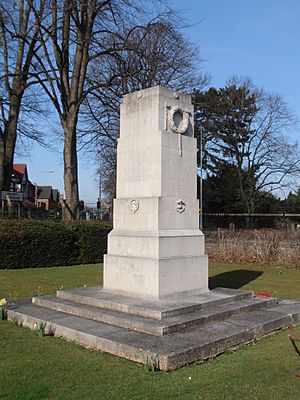Welch Regiment War Memorial facts for kids
Quick facts for kids Welch Regiment War Memorial |
|
|---|---|
| United Kingdom | |
 |
|
| For men of the Welch Regiment killed in the First World War | |
| Unveiled | 11 November 1924 |
| Location | 51°29′54″N 3°11′03″W / 51.49831°N 3.18419°W Maindy Barracks, Cathays, Cardiff
|
| Designed by | Sir Edwin Lutyens |
|
Listed Building – Grade II
|
|
| Official name | Welch Regimental War Memorial at Maindy Barracks, Cathays |
| Designated | 19 May 1975 |
| Reference no. | 13828 |
The Welch Regiment War Memorial, also called the Maindy Monument, is a special monument in Cardiff, Wales. It remembers the brave soldiers of the Welch Regiment who died in the First World War. This memorial is located at Maindy Barracks in the Cathays area. It was designed by a famous architect, Sir Edwin Lutyens, and looks like his well-known Cenotaph in London. The memorial was officially revealed on November 11, 1924. Today, it is a protected building, known as a Grade II listed building.
Contents
Why War Memorials Were Built
After the First World War (1914-1918), many people had lost loved ones. So many soldiers died that communities across Britain wanted to build special places to remember them. Thousands of these war memorials were created.
Sir Edwin Lutyens' Designs
One of the most important designers of these memorials was an architect named Sir Edwin Lutyens. He was known as a top English architect of his time. Sir Edwin Lutyens designed the famous Cenotaph in London. This monument became the main place for national Remembrance Day events. He also designed the huge Thiepval Memorial to the Missing in France. This is the largest British war memorial anywhere in the world.
Lutyens also created the Stone of Remembrance. You can find these stones in many large cemeteries where soldiers are buried. The Welch Regiment War Memorial is one of eight similar monuments Lutyens designed in Britain. It is also the only one of his war memorials located in Wales.
About the Memorial's Design
The Welch Regiment War Memorial is a type of monument called a cenotaph. A cenotaph is a tomb or monument built to honor people whose remains are elsewhere. This memorial is made from a special kind of stone called Portland stone.
Memorial Features
The monument stands on a base with three steps. It has a square bottom part and a stepped platform. The front and back of the memorial have important messages carved into them. The north side has inscriptions in English, and the south side has them in Welsh.
On the east and west sides, you can find the names of soldiers from the Welch Regiment. These names are from the First World War and the Second World War. Later, names from the Korean War (1950-1953) were also added. The top parts of the east and west sides have beautiful carvings of a laurel wreath. This is a symbol of victory and honor. The lower parts of each side show the regiment's special cap badge.
Unveiling the Memorial
The Welch Regiment War Memorial was officially revealed on November 11, 1924. Major-General Sir Thomas Marden led the ceremony. The Reverend Ernest Thorold performed the dedication, which is a special blessing for the monument.

